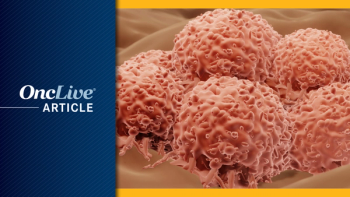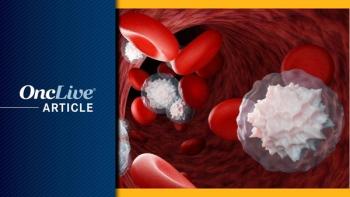
VERU-111 Elicits Early Efficacy Signals in Pretreated mCRPC
February 11, 2021 - The novel tubulin inhibitor VERU-111 demonstrated early antitumor activity and a well-tolerated safety profile in patients with metastatic castration-resistant prostate cancer who failed a prior androgen receptor–targeting agent.
The novel tubulin inhibitor VERU-111 demonstrated early antitumor activity and a well-tolerated safety profile in patients with metastatic castration-resistant prostate cancer (mCRPC) who failed a prior androgen receptor (AR)–targeting agent, according to findings from a phase 1b study that were presented during the 2021 Genitourinary Cancers Symposium.1
In 10 men who reached at least four 21-day cycles of continuous dosing with VERU-111, 6 experienced a decline in prostate-specific antigen (PSA). Moreover, 4 obtained a 30% or greater decline in PSA and 2 had a 50% or greater decline in PSA.
Two men experienced partial responses and 8 men experienced stable disease as best objective tumor response. Two additional objective responses occurred in patients who did not reach 4 cycles of continuous dosing.
The median duration of treatment without progression was greater than 11 months (range, 6.0-22.0). Three men remain on study and have a median duration of treatment without progression of more than 10.5 months (range, 4.2-22+).
“The data from the phase I study showed VERU-111 is safe and well tolerated at continuous daily dosing,” said Mark Christopher Markowski, MD, PhD, lead study author and assistant professor of oncology at Johns Hopkins Medicine, in a statement to OncLive®. “We are excited to develop an oral therapy for men with metastatic prostate cancer that does not directly target the AR signaling pathway. In the future, VERU-111 may serve as an alternative to intravenous taxane chemotherapies in men with advanced disease.”
VERU-111, a “railroad tracks disruptor” that targets the cytoskeleton, binds to the α and β tubulin subunits of microtubules. Furthermore, the agent targets the colchicine binding site to crosslink these subunits, inhibit microtubule polymerization, and downregulate intermediate filaments of the cytoskeleton.
The agent demonstrated high oral bioavailability in preclinical studies, with a favorable toxicity profile and activity against taxanes, vinca alkaloids, doxorubicin, enzalutamide (Xtandi), and abiraterone acetate (Zytiga)–resistant prostate cancers.
The open-label, phase 1b, dose-escalation portion of the study utilized a 3+3 design. Eligible patients (n = 39) had to have mCRPC and received 1 prior AR-targeted therapy. Additionally, patients who had received up to 1 prior line of taxane-based chemotherapy for mCRPC were included.
In part 1 of the phase 1b trial, patients received oral VERU-111 daily on days 1 through 7 of a 21-day cycle. In part 2, patients who tolerated the 7-day dosing schedule escalated to a 14-day schedule every 21 days. If the 14-day schedule was tolerated, patients escalated to continuous daily dosing of VERU-111 until disease progression or unacceptable toxicity.
Patients (n = 39) were a median age of 74 years (range, 61-92) and had a median sum Gleason score of 8 (range, 5-10). The majority of patients (n = 28; 72%) were Caucasian, and the remainder of patients were African American (n = 8; 21%) or Hispanic (n = 3; 8%).
Over half of patients (n = 21; 54%) had an ECOG performance status (PS) of 0; 41% and 8% had an ECOG PS of 1 and 2, respectively.
Sites of metastatic disease included bone only (n = 21; 55%), lymph node only (n = 6; 16%), bone and lymph node (n = 8; 21%), visceral (n = 1; 3%), and visceral and bone (n = 1; 3%).
Prior therapies included abiraterone (n = 14; 36%), enzalutamide (n = 8; 20%), abiraterone and enzalutamide (n = 17; 44%), and taxane-based chemotherapy (n = 9; 23%).
An efficacy analysis of patients who received the recommended phase 2 dose (RP2D) of 63 mg and were evaluable for efficacy (n = 16) showed that the median duration of treatment without progression was greater than 5.8 months (range, 0-22+). Excluding patients who discontinued treatment because of adverse effects (AEs), the median duration of treatment without progression was great than 9.8 months (range, 2-22+).
Notably, the poster presentation included 2 patient case studies.
The first patient had a Gleason score of 9 and node-only mCRPC. Prior treatments included sipuleucel-T (Provenge), enzalutamide, and abiraterone. The patient remained on study for more than 22 months and experienced a 63% decline in PSA from baseline at initiation of the first 21-day cycle.
A screening CT scan from March 8, 2019 showed a 1.7 cm by 1.5 cm measurable target lesion in the retroperitoneal lymph node. A 15-month follow-up scan completed on June 10, 2020 showed a 33% decrease in size to a nonpathologic node; the tumor shrunk to 1.1 cm by 1.0 cm.
The second case study highlighted a 73-year-old patient who received the 72-mg dose of VERU-111. The patient had bone- and node-positive mCRPC, a Gleason score of 8, and progression on leuprolide acetate (Lupron), sipuleucel-T, enzalutamide, and abiraterone.
At baseline, the patient had a 7 cm by 3.1 cm target lesion in the right obturator lymph node. Subsequent scans showed tumor shrinkage to 7 cm by 2.4 cm at 4 months and 5.4 cm by 2.4 cm at 5 months, representing a best reduction of 23%. Overall, the patient received VERU-111 for 7 months and obtained a 36% decline in PSA from baseline at initiation of the first 21-day cycle.
Regarding safety in the overall dose-escalation cohort, the most common all-grade treatment-related AEs (TRAEs) reported in more than 2 patients across all dosing levels included diarrhea (n = 38), fatigue (n = 24), and nausea (n = 21). Other all-grade TRAEs included anemia (n = 6), anorexia (n = 3), decreased appetite (n = 8), dizziness/lightheadedness (n = 3), dysgeusia (n = 4), elevated alanine transaminase (n = 5), elevated aspartate transaminase (n = 5), hyponatremia (n = 4), neutropenia/neutrophil decrease (n = 5), vomiting (n = 8), and weight loss (n = 8).
Of these TRAEs, grade 3 events included anemia (n = 1), diarrhea (n = 3), fatigue (n = 3), nausea (n = 1), and vomiting (n = 1).
In the 25 patients who received the RP2D of oral VERU-111 for at least 1 cycle, the majority of AEs were grade 1 or 2. All AEs observed included diarrhea (n = 17; 68%), nausea (n = 8; 32%), decreased appetite (n = 5; 20%), constipation (n = 4; 16%), fatigue (n = 4; 16%), vomiting (n = 4; 16%), dysgeusia (n = 3; 12%), weight loss (n = 3; 12%), abdominal cramping (n = 2; 8%), edema in the lower extremity (n = 2; 8%), and low white blood cell count (n = 2; 8%).
All drug-related AEs included diarrhea (n = 14; 56%), nausea (n = 6; 24%), decreased appetite (n = 3; 12%), fatigue (n = 3; 12%), dysgeusia (n = 3; 12%), weight loss, (n = 3; 12%), vomiting (n = 2; 8%), and low white blood cell count (n = 2; 8%).
Additionally, 1 patient experienced a grade 3 or greater, drug-related fatigue at the 63-mg dose. The patient was reduced to a 54-mg dose, and the fatigue resolved.
A phase 2 trial of VERU-111 in patients with mCRPC who are resistant to an AR-targeted agent who have not received prior intravenous chemotherapy is ongoing (NCT03752099).2 Patients will start on 63 mg of continuous, daily VERU-111. If unacceptable toxicity occurs, patients will be reduced to 54 mg of continuous, daily dosing.
The primary end point of the study is radiographic progression-free survival (rPFS). Initial results reported that objective tumor responses have been observed, including a complete response. PSA responses, including PSA declines of more than 50%, have also been observed. Patients have remained on study for more than 9 months, and the safety profile appears similar to that observed in the phase 1b study.
“Our data suggests [that] VERU-111 warrants further study. Enrollment on the phase 2 portion of the study is complete, and we look forward to sharing those results,” Markowski added.
The investigators also reported that a positive meeting with the FDA regarding VERU-111 took place in July 2020. As such, the pivotal phase 3 VERACITY trial is set to launch in early 2021. Because rPFS is set to be the primary end point, the sample size of the phase 3 study could include between 200 and 300 men.3
References
- Markowski MC, Eisenberger MA, Tutrone RF, et al. Clinical study of VERU-111, an oral cytoskeletal disruptor in men with metastatic castration resistant prostate cancer (mCRPC) who failed an androgen receptor targeting agent. J Clin Oncol. 2021(suppl 6):131. doi:10.1200/JCO.2021.39.6_suppl.131
- To evaluate safety and tolerability of VERU-111 in men with advanced metastatic castration resistant prostate cancer. ClinicalTrials.gov. Posted November 23, 2018. Updated February 2, 2021. Accessed February 11, 2021.
https://clinicaltrials.gov/ct2/show/NCT03752099 . - VERU-111. Veru Inc. 2021. Accessed February 11, 2021.
https://verupharma.com/pipeline/veru-111/ .

























































































